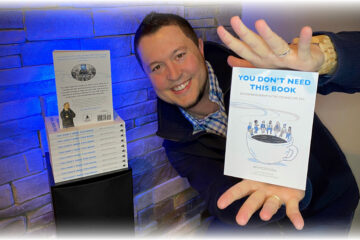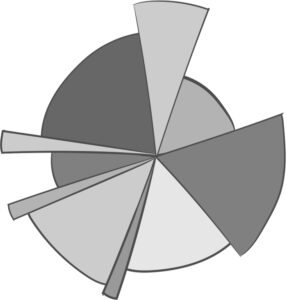You Don’t Need This Book officially went on sale April 1st!
To commemorate this milestone, here’s the story of how I rolled everything I know about entrepreneurship into 37,456 words that spans just 200 pages.
Inspiration
Over the past 15 years, my own entrepreneurial, intrapreneurial and community building experiences created a baseline of understanding. Along with my own journey, I’ve extracted insight from thousands of students, entrepreneurs, intrapreneurs, mentors, investors and entrepreneurial ecosystem builders.
With all that bottled up brain power, I started to feel as if I may regret not passing my experiential wisdom on.
Catalyzed
This book started as an outline on my phone. Each of the chapters represented a pillar of entrepreneurship. It lingered there for around six months. As you’ll read in the Foreword of my book, Victor Hwang and I were talking about this literary project back in 2019. He shared a poem with me that really resonated. My interpretation was that everyone has a story to tell. When it starts to keep you up at night, it may be time to put pen to paper. I had reached this tipping point so on January 1st, 2020, I opened a blank Word document, dropped in my outline and began to write.
Composition
For the next few months, I focused on finding 1-3 hour blocks to write. Some authors jump around and write into areas they feel most confident about before stitching things together. I chose to write from start to finish in what felt like the most common path for an entrepreneurial experience. The ease at which this story started coming together energized the work and made me even more determined. Along with writing, I learned as much as I could about book publishing. Seth Godin’s advice for authors guided me, but a growing collection of bookmarks kept the research going. The COVID-19 pandemic hit so I leaned on more wisdom from Seth Godin to find my inspiration at home. EDM kept flowing in my ears and my written words continued to construct the story. After around six months I had reached my goal of 25K words, but then the hard work began.
Refinement
With my first draft written, I brought everything into software to simplify, clarify and embolden the manuscript. I also focused on removing duplicative thoughts and optimizing the overall flow. This process took way longer than I expected, but the result was a dashing manuscript ready for review. My brilliant wife read it first. I knew that if the most intelligent/thoughtful person I knew approved, I could move forward. She loved it and helped me improve the readability even more. I then sent the manuscript and a book summary to family, mentors and other early readers. I implemented their feedback and kept building into this document that really started to feel like a book.
Polish
With a solid manuscript in place, I reached out to Victor Hwang and asked if he would do me the honor of writing the Foreword. When he said yes, I asked Brad Feld if he would like to contribute into the Entrepreneurial Ecosystem section of the Community chapter. As you’ll read in the Acknowledgements, jamming with these rockstars was a special treat. Having two thought leaders complimenting the manuscript provided me confidence and their contributions added some remarkable credibility to the book.
Extra Shot
The manuscript was written without the Oxford Comma. Based on Brad Feld’s comments, a quick Twitter poll and both of the editor’s suggestions, the serial comma got woven in right before publishing.
As these contributions came together, Brad Feld introduced me to the developmental editor who worked on Techstars books in the Startup Revolution library. Collaborating with Pete Birkeland resulted in the addition of my Introduction section and the 20+ personal sidebars you’ll see throughout the book. I then asked Michael McConnell to be my final copy editor. He had worked with authors like Seth Godin and Todd Henry, so it was neat working with an expert to a polish every single word to make the manuscript ready to publish.
Publishing
It took an entire year for the manuscript to emerge. I had been talking with different publishers and researching the publishing process as the manuscript came together. With a project that became so personal, I often felt paralyzed by this foreign process. This paralysis was not from a lack of options, but instead, so many options that it made me question so many decisions that had to be made. To navigate through the fog, I kept asking questions, digging deeper and decided to create my own publishing company to wrap around this project.
I then began collaborating with Nathan T. Wright on cover art. This was a magical experience that became icing on the cake. With so much influence from Seth Godin, I also decided to reach out to my hero for the very first time. This interaction with my favorite thinker is something I’ll always remember and the epic result was the only blurb you’ll see on the back of my book! With caffeinated cover art in place, I learned how to design every interior page to give readers a exceptional experience. Pour Over Publishing unlocked preorders four weeks before the official launch, as I worked with Amazon and IngramSpark to finalize the softcover and eBook that are now about to ship worldwide.
Results
Whether this becomes a bestseller or not, You Don’t Need This Book: Entrepreneurship in the Connected Era is now something I can be proud of for the rest of my life. It was an unbelievable amount of work, but I’m thankful for the support of so many people which allowed me to persevere. I enjoyed sharing this first look video and have activated community-driven marketing as we prepare for launch day.
Extra Shot
Wanna help spread the word? Here’s a media library to make your posts pop. To say thanks, feel free to use the friendly coupon codes as well!
Publishing my first book and watching sales roll in provides a sense of accomplishment, but I’m most excited to hear how YDNTB makes an impact with people like you. I simply cannot wait to hear how this synthesized narrative helps you build that new business, improve an existing company, fire up a side hustle or evolve your own entrepreneurial ecosystem!
In addition to more caffeinated conversations, now that I’ve navigated the fog, there may be more ways to accelerate others by helping hidden leaders write their own book. I’ll leave you with an open invitation. If the story in your mind starts to keep you up at night, let’s chat about evolving your ideas into reality.

